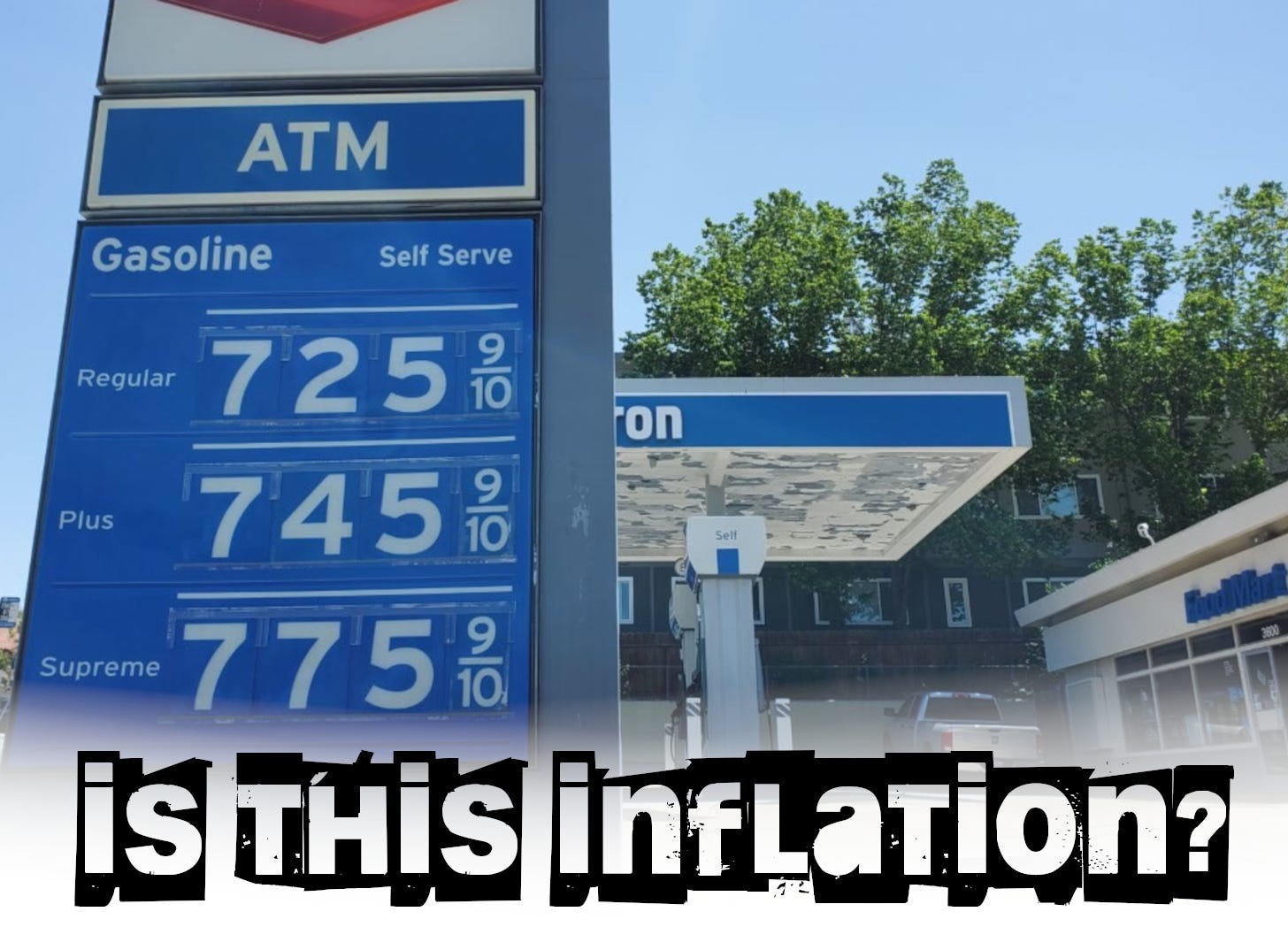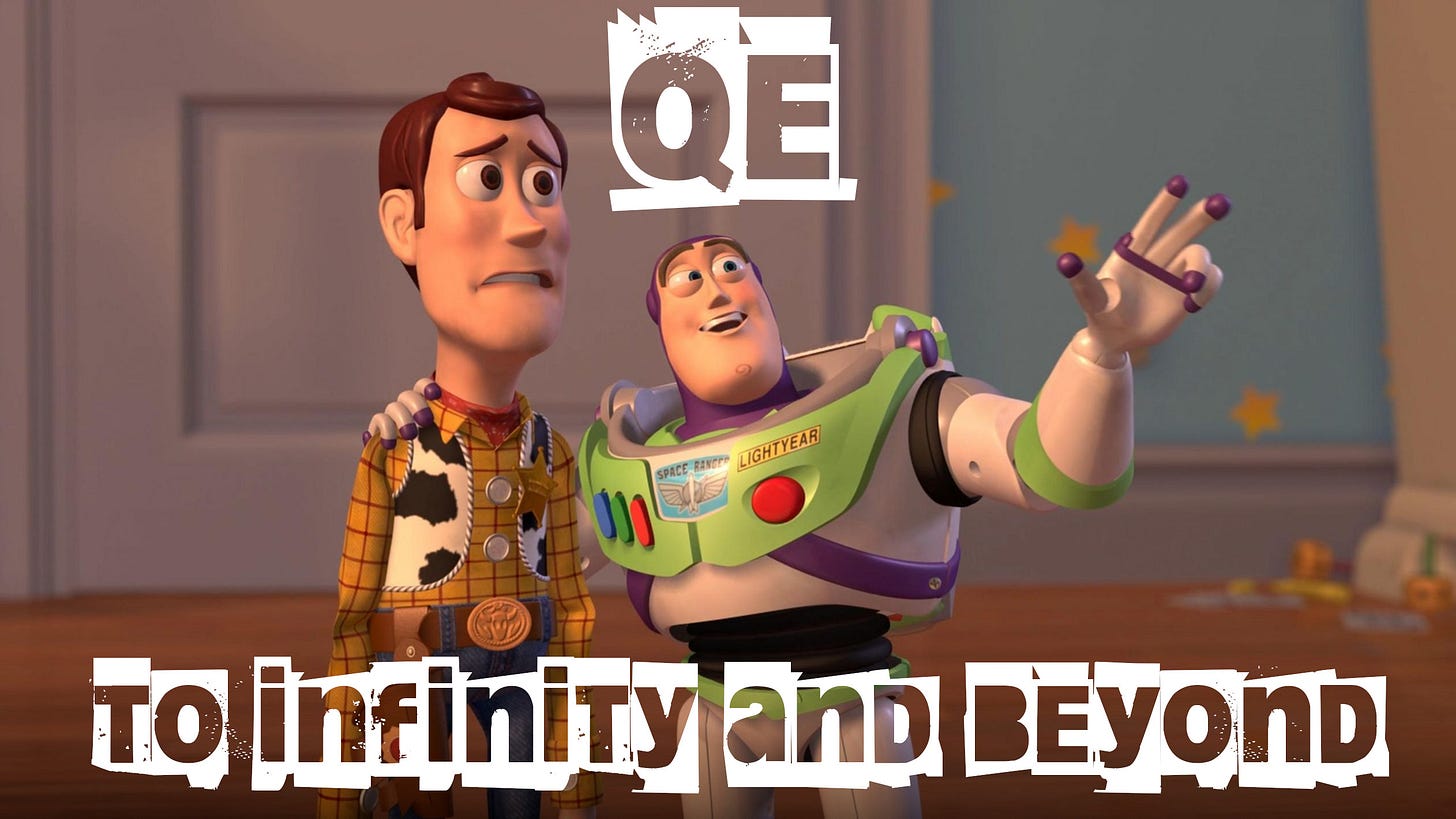I have a healthy respect for Mike Green*, Jeff Snider and Hugh Hendry. As such, I’ve spent the last six months trying to figure out why the hell they’re all saying we don’t have inflation.
*I’m not sure I’ve heard Mike explicitly say we don’t have inflation, but I know that he believes the price rises are not related to money printing, they’re a supply side issue.
The price of a steak at my local grocery store has doubled in the last six month, so there’s clearly something going on here. What is that if not inflation? I’ve been chucking the question around the ol’ thinker since the summer and the conclusion I’ve reached is that we need to inflate the language we use to talk about inflation.
Specifically, we need two sets of terms that will allow us to differentiate between monetary inflation, and supply-side inflation. Understanding the difference between these two phenomena isn’t just cocktail party trivia. Using better language could have an effect on policy and the fiscal/monetary/political response that we use to put a damper on rising prices. Let’s dive in.
Part 1 - Why we don’t have inflation
The claim that we don’t have “true” inflation is based on Milton Friedman’s idea that, “Inflation is always and everywhere a monetary phenomenon, in the sense that it is and can be produced only by a more rapid increase in the quantity of money than in output.”
Milton is suggesting that we should only consider price rises to be inflation when they’re the result of money printing. As I explained in my piece, Is QE money printing, when the Fed engages in quantitative easing it’s not really printing money. The Fed creates bank reserves and swaps them for Treasuries. The bank reserves are an inert asset, you can’t spend them at the pub or the car dealership. JP Morgan cannot buy off politicians with bank reserves, our glorious leaders only accept dollars which the Fed is incapable of creating.
When Hugh gets on stage and says, we don’t have inflation! And yet everything costs a lot more than it did 18 months ago, he’s saying that we don’t have inflation caused by the Federal Reserve expanding the money supply. So if not the money, then what?
Part 2 - Why are prices rising?
In 2020 our enlightened leaders shut down the economy, decimated our productive capacity and then sent everyone a bunch of money and told them to spend it. Furthermore, without a services economy (which makes up two-thirds of global GDP), tens of millions of people had a lot of money and only limited options to as where they could spend in. Hence there was an unusually high demand for goods, and insane speculation in the markets.
Fiscal stimulus combined with restricted supply led to large imbalances in supply and demand that are still being felt to this day. While not every country sent out stimmies like America, many jurisdictions shut down companies, stopped people from working and otherwise kicked the teeth out of the just in time supply chains that we depend on. In other words, prices are going up now because there is a lack of supply. Whether it’s oil, semiconductors or boba tea bubbles; disruptions in manufacturing, shipping and distribution have led to everything costing more.
To push back a bit, is it fair to attribute 100% of elevated prices just to limited supply? No, I don’t think so. As I mentioned in my QE article, even though quantitative easing is not money printing, I still think there can be inflationary effects. For example, you could argue that consumers might have spent less and saved more if the messaging from the Fed and other financial authorities had been, “you’re on your own, plan accordingly.” Also, the government might not have been able to spray all that stimulus around if they weren’t reassured by the Fed backstopping the Treasury market.
While you can make a case that supply side constraints are not the full picture, I think that directionally the supply imbalance is correct. If that’s the case, then I think we need more specific language to describe the rises in prices.
Part 3 - A proposal for new inflation language
The necessity of better terminology has been on my mind for a while, but only recently has a solution arisen. Near the end of this video, Jeff uses the word “efficiency” to describe the multi-decade trend of falling prices I.e. a 42 inch TV going from $3,200 to $320. While the term “efficiency” might not be perfect, it’s a heck of a lot better than the alternative, which is nothing. Here’s how we could implement this language.
Efficiency - Price declines caused by better manufacturing techniques, higher productivity, digitization and price-optimized supply chains. Broadly speaking, price declines caused by improvements in the physical world.
Inefficiency - Price increases caused by factories shutting down, supply chains breaking, higher oil prices due to global strife, material shortages, higher fertilizer costs, etc. Broadly speaking, price increased caused by failures in the physical world.
Inflation - Price increases caused by honest to God money printing: the Weimar Republic.
Deflation - Price decreases caused by the destruction of wealth and the money supply: the great depression.
Part 4 - How language effects policy
If we have an “efficiency” problem and not an “inflation” problem, the Federal Reserve raising rates is not going to solve anything. In fact, to the extent that it sinks the economy into recession, makes borrowing more expensive and bankrupts businesses, higher rates may exacerbate the inefficiencies. If we need businesses and corporations to expand their operations and solve the supply crisis, then it stands to reason that blowing up the corporate bond market is probably not a 200 IQ move.
Many people on Twitter have used the beach ball analogy. The Fed may be able to temporarily lower prices by killing demand (pushing the ball underwater). However, if the structural inefficiencies are not fixed then as soon as conditions ease, the demand will return and beach ball of prices will rise again. If you think about the Fed’s endgame it’s what, exactly? Keep the United States in recession forever? Make everyone so poor that they have no money left to spend on anything?
If we had better language the Fed could say, “we believe that the price hikes we’re currently experiencing are mostly caused by supply bottlenecks and inefficiencies resulting from the morons our esteemed leaders locking down the economy for a year. Raising interest rates cannot solve a supply-side problem. If we want to check the rise in prices, we need to invest in new infrastructure and bring more energy production online.”
Part 5 - Finale
The Eskimos supposedly have 50 words to describe snow. Maybe that’s a made up statistic, but it sounds cool anyways. Unlike the Eskimos and their snow, inflation is the only word we have to describe a rise in prices. This is inadequate. Whether we use Jeff’s “efficiency” or some other phrase, we need better language that will allow us to make a distinction between price hikes caused by an inflated money supply, versus those caused by structural issues in manufacturing, the supply chain, labor shortage, energy shortages, etc.
Do you agree? Disagree? If you have an opinion I would love to hear it, I have an open mind that’s willing to hear all arguments.
Every Sunday I publish a recap of all the best finance articles and podcast episodes I’ve found thought-provoking. Here’s the latest edition.
If you’d like to get this free newsletter straight to your inbox just enter your email below 👇








True enough, the term inflation is employed rather haphazardly. We should understand there is a difference between price increases in a particular market (oil for example) due to any number of market specific factors (geopolitics etc.) and general price inflation, which is driven by a decline in the price of the currency in question (goods and service/currency unit). Currency price changes are driven, most fundamentally, by the same overarching forces that drive the price of any asset or good...supply and demand. The focus tends to be on currency debasement/supply increase (absolutely one of the two key factors) while demand, or confidence in the case of currency, is often overlooked or an afterthought. Note, demand/confidence is the factor which can change suddenly and dramatically; much like the sharp fall of a stock following news which surprises the market. Note, a collapse in demand for/confidence in a currency can absolutely occur amid general economic collapse, as evidenced many times through financial history, which will leave central banks both mystified and powerless. Unless another even more extreme speculative mania can be fomented, by pushing short rates to new lows, there are only two options for resolution of monetary distortions; deflationary collapse or inflationary collapse. Given that central banks pushed short rates to zero during the last bout odds are we on approaching inevitable resolution of four decades of massive monetary distortion. Accelerating debasement and confidence collapse are likely the safe bet. Tangible assets offer refuge for those who act early but somebody, meaning most everyone, must hold the financial paper all the way down (in real terms), it won't just conveniently go away; other than to the extent that central banks "buy" the paper by conjuring currency out of thin air through nothing more than accounting entries.
I'm going to get my Substack active soon. Fundamentals of general price inflation might be a timely opening topic. BTW, I'm a new to your Substack.
Is this you on Twitter? https://twitter.com/UnhedgedCapital